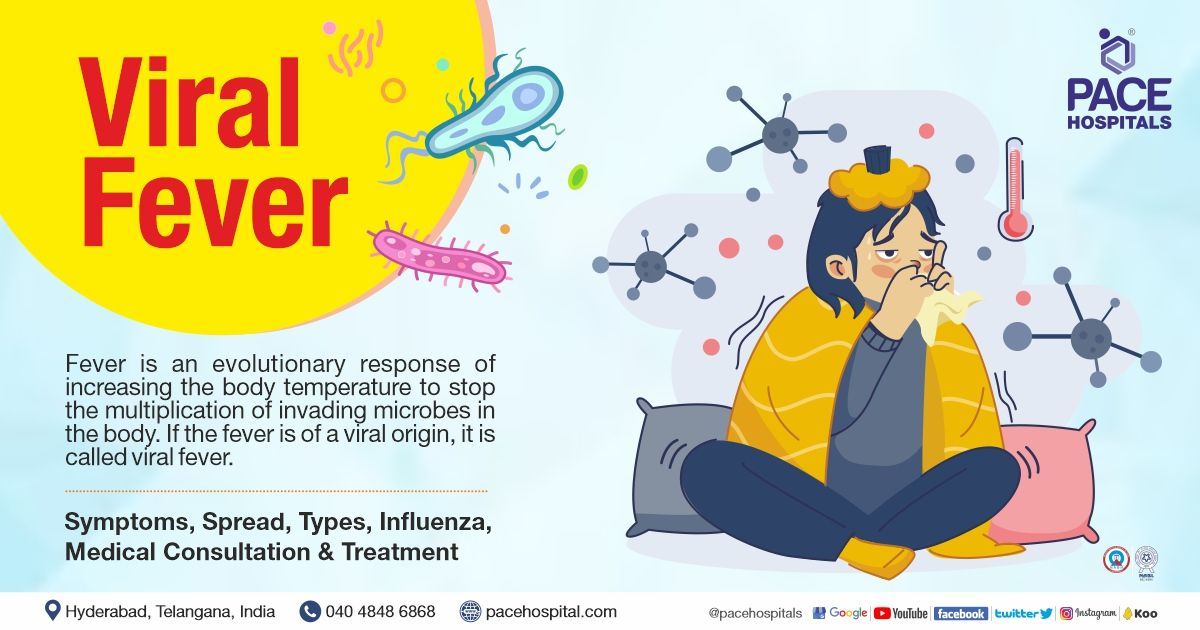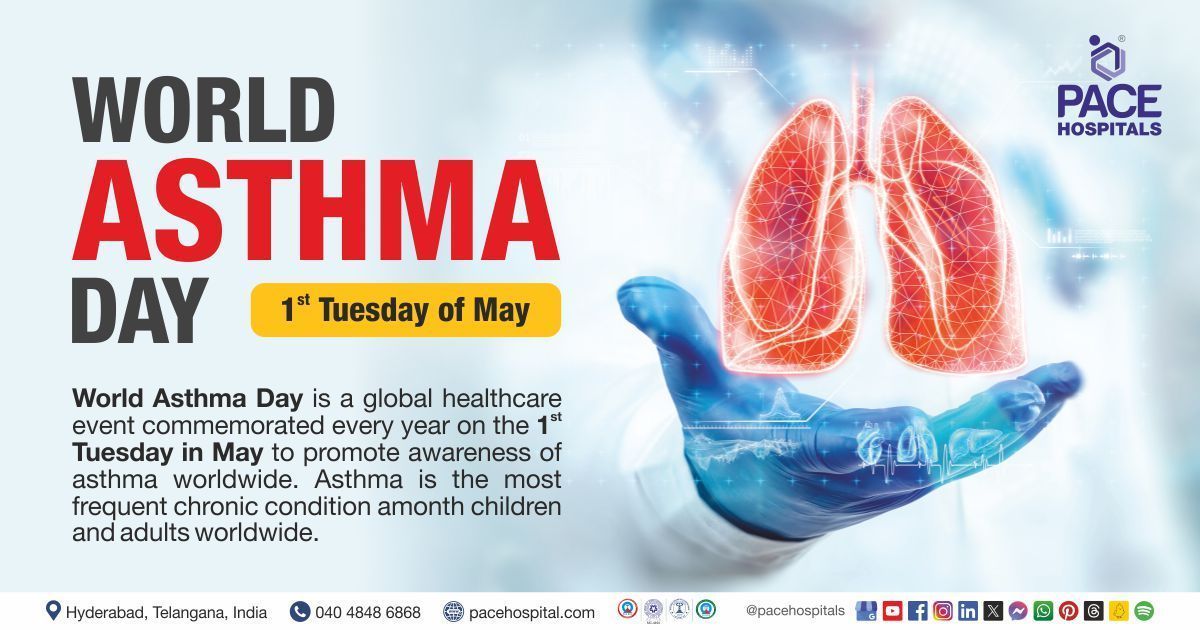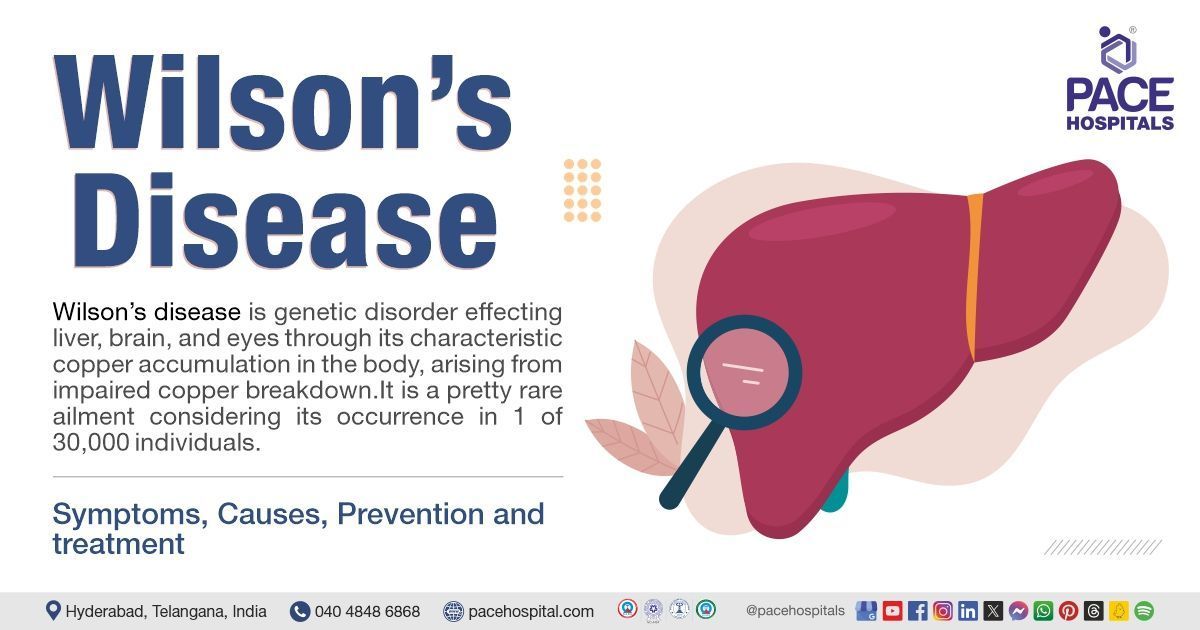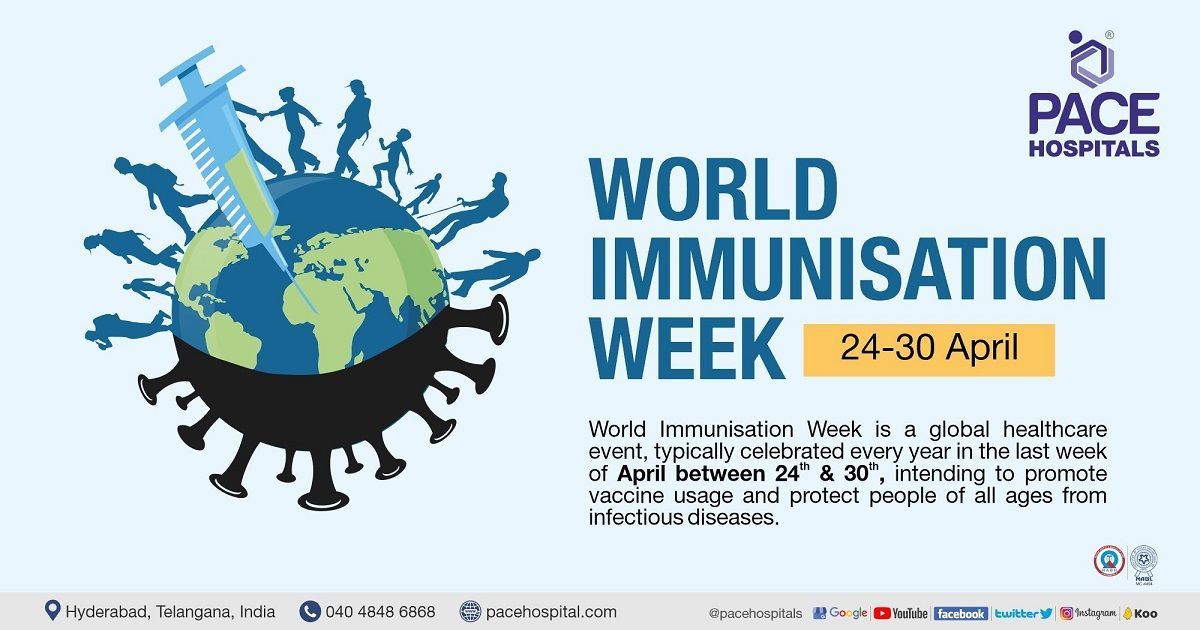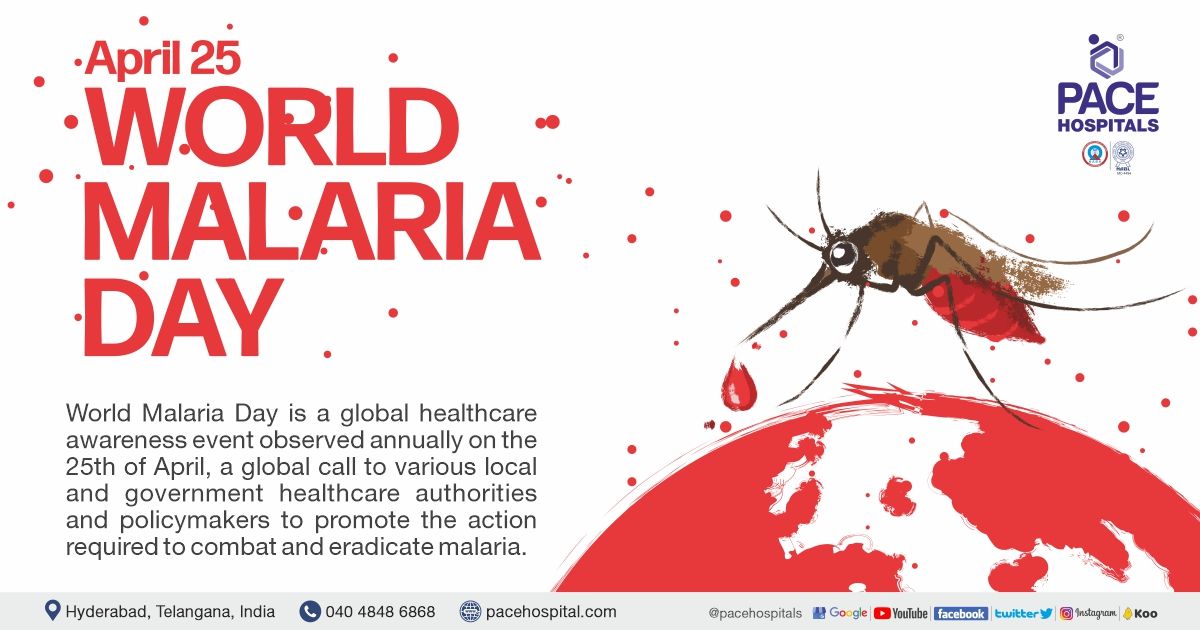Viral Fever - Symptoms, Causes, Types, Prevention, Treatment
Fever Overview
Fever meaning
The normal core temperature of humans could vary between 97.7 °F - 100.04 °F (36.5 °C - 37.8 °C). Any increase in the body temperature is called fever.
Hypothalamus is a small structure situated deep in the brain, and its main function is the maintenance of homeostasis, i.e., keeping the body in a stable state, which includes regulation of body temperature as well. The hypothalamus often develops a new regulatory set point causing fever for various reasons (for example, infection or inflammation).
A common immunological response to a plethora of bacterial and viral infections, fever, is seen not only in humans but across the animal kingdom, which could suggest an evolutionary benefit.
The Viral Fever - Overview
Viral fever meaning
The increase in bodily temperature due to the infection caused by the virus falls into the category of viral fever. These small ubiquitous microorganisms, the virus, usually range from a few hundred nanometres in size.
Deriving from the Latin word virus, meaning poison, these microorganisms contain a single nucleic acid (RNA or DNA) core and are surrounded by a protein coat. The severity of the fever depends on the virulence of the microorganism and the host's response to the infection.
Causes of Viral Fever
The virus is ever present around us, looking for a chance to attack us for their survival, during which various symptoms such as the fever, cold, cough may appear. Majority of the giant viruses do not cause any harm, neither to humans nor animals, and do not destroy crops. Nevertheless, there are various viruses which attack the humans causing viral fever. Below are the viruses which may cause viral fever in acute infection:
| Virus | Disease in humans |
|---|---|
| Adenoviruses | Bronchitis, Pneumonia, Gastroenteritis |
| Herpesviruses | Herpes, Chickenpox |
| Parvoviruses | Slapped Cheek Syndrome, Arthritis |
| Reoviruses | Gastroenteritis |
| Coronaviruses | COVID-19, SARS, MERS |
| Togaviruses | German Measles, Encephalitis |
| Orthomyxoviruses | Influenza |
| Rhabdoviruses | Rabies |
| Retroviruses | AIDS and a few cancers |
| Hepadnaviruses | Hepatitis |
Ways of spreading viral infections
Common ways of contracting viral infections, which could, in turn, lead to viral fevers, are through:
- Coughing, sneezing
- Contacting surfaces or objects which may contain a virus as someone with a viral infection has touched (like counter tops, doorknobs or phones).
- Sexual contact (like vaginal, oral, or anal contact).
- Bites (usually infected insect bites like mosquitoes or ticks).
- Contaminated food or water.
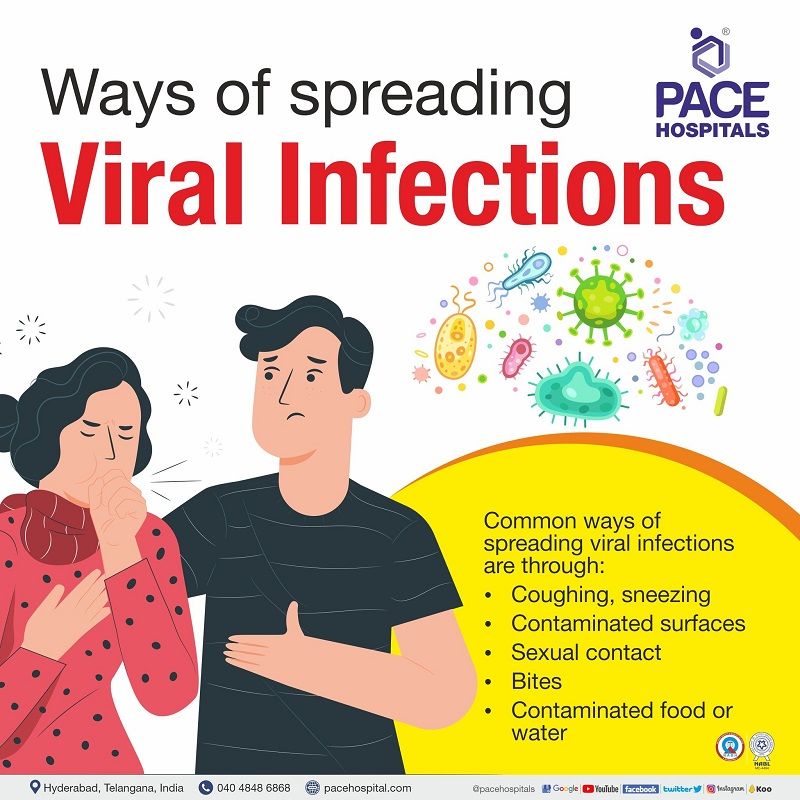
Viral fever symptoms
Viral fever symptoms depend upon the types of viral infections, some of the below general symptoms of viral fever may include:
- Higher Body temperature (99 °F to 103.5 °F; 37.25 °C to 39.5 °C)
- Frequent chills with shivering or shaking
- Fatigue and weakness or tiredness
- Headache (pain in any region of the head)
- Sore throat (Pain or irritation of the throat)
- Runny nose (Rhinorrhea)
- Muscle pains (Myalgia)
- Sweating (Perspiration)
- Appetite loss
- Dehydration
Fever is a symptom of various diseases, which can be determined by the measurement of the increase of body temperature. The various types of viral infections which could cause fever are explained below:
Accompanying the infection, the four classic vital signs are respiratory rate, temperature, pulse rate and blood pressure. Their measurement has been a standard practice for over a century.
It was not until 1966 that the prognostic significance of the relationship between a high heart rate and low blood pressure was recognized. Subsequently, pulse oximetry (measurement of oxygen saturation (SpO2)) has been proposed as the fifth and altered mental status as the sixth vital sign.
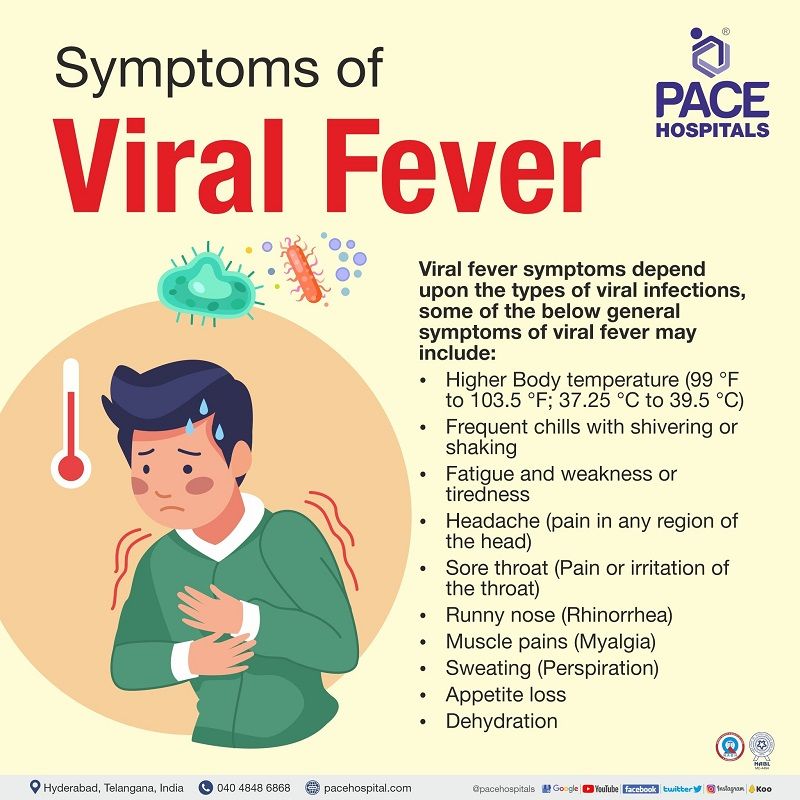
Types of viral infections
There are various types of viral infections, depending majorly on the site infected. They are:
- Upper respiratory infections include sore throat, sinusitis, and the common cold.
- Gastrointestinal tract infections, such as gastroenteritis.
- Hepatitis is a group of viral infections caused by hepatitis viruses (A, B, C, D, and E).
- Neurological infections could include encephalitis, meningitis etc.
- Dermal infections by the virus can cause warts or other blemishes. Many viruses affecting bodily systems can also result in various other dermal manifestations, such as chickenpox causing rashes.
- Infections of the placenta and foetus: Few viruses, especially the cytomegalovirus, Zika virus, and the rubella virus, could infect the placenta and foetus in pregnant women.
Apart from these above-explained viruses, there are a few specific viruses which typically affect the bodily systems, such as enteroviruses and cytomegaloviruses.
Upper respiratory infections: The viral infections infecting the upper respiratory tract are a few of the most common viral infections.
These simple viral infections of the nose, throat, upper airways, and lungs can include sinusitis, sore throat, and the common cold. Other serious viral respiratory infections include pneumonia, influenza, and SARS-CoV-2.
These viral respiratory infections are more likely to show severe symptoms in infants, the elderly, and people with a heart or lung disorder. These respiratory viruses are typically contact through with infected respiratory droplets.
In paediatrics (small children), the viruses commonly cause laryngotracheobronchitis (inflamed upper and lower airways, also called croup) and bronchiolitis (inflamed lower airways).
Influenza is one of the common communicable viral diseases which affects due to seasonal change.

Influenza viral fever
Influenza is a disease that can spread and affects both the lower and upper parts of the respiratory tract and is caused by flu viruses which can spread through the tiny droplets from an infected person's coughing, talking, or sneezing.
Influenza can be passed on before the person has any symptoms and up to 5–7 days after the infection. While healthy people need a few days to fully recover from an infection, few patient groups, such as young children, pregnant, the elderly and people with weak immune systems, may often have complications like pneumonia and death.
The flu symptoms include:
- Runny nose
- Cough
- Sore throat
- High viral fever
- Congested eyes
The body temperature during influenza viral fever could range around 103 °F to 105 °F (39.4 °C - 40.5 °C). During seasonal epidemics, the flu spreads quickly and effectively. Flu epidemics happen every fall and winter in temperate regions. They affect many adults and children, but the age groups and severity are different each season.
Viral hemorrhagic fever - Overview
Viral hemorrhagic fevers (VHFs) are a set of serious systemic fevers caused by four virus families: Arenaviridae, Bunyaviridae, Filoviridae, and Flaviviridae. The symptoms of Viral hemorrhagic fevers include coagulopathies, hemodynamic instability, changes in mental state, and, in extreme cases, death.
Viral hemorrhagic fever causes
Most viral hemorrhagic fevers are spread by contacting infected insects or animals, as the viruses causing viral hemorrhagic fevers survive in a variety of animal and insect hosts such as rodents, bats, mosquitoes, or ticks. In some cases, it could be spread from person to person.
The causative agents of viral hemorrhagic fevers include virusus from the four virus families: Arenaviridae, Bunyaviridae, Filoviridae, and Flaviviridae.
Signs and symptoms of viral hemorrhagic fever
Patients suffering from any of the various viral hemorrhagic fever could present with various generalised symptoms such as
- Fever
- General malaise
- Headache
Nevertheless, in severe cases and in patients with reduced immune deficiency the associated symptoms include
- Retro-orbital discomfort
- Joint aches
- Redness of the eye
- Abdominal pain
- Vomiting and nausea
- Diarrhoea
- Epistaxis (nose bleeds)
- Bleeding gums
Types of viral hemorrhagic fever
These viral hemorrhagic fevers are caused by four virus families: Arenaviridae, Bunyaviridae, Filoviridae, and Flaviviridae. The different types of viral hemorrhagic fevers are:
Arenaviridae family:
- Guanarito virus (GTOV) - Venezuelan hemorrhagic fever
- Chapare virus (CHPV) - Chapare hemorrhagic fever
- Lassa virus (LASV) - Lassa fever
- Junin virus (JUNV) - Argentine hemorrhagic fever
- Lujo virus (LUJV) - Lujo hemorrhagic fever
- Lymphocytic choriomeningitis virus (LCMV) - Lymphocytic choriomeningitis
- Machupo virus (MACV) - Bolivian hemorrhagic fever
- Sabia virus (SABV) - Brazilian hemorrhagic fever
Bunyaviridae family:
- Crimean-Congo hemorrhagic virus (CCHFV) - Crimean-Congo hemorrhagic fever
- Dobrava-Belgrade virus (DOBV) - Hemorrhagic fever with renal syndrome
- Hantaan virus (HTNV) - Hemorrhagic fever with renal syndrome
- Saaremaa virus (SAAV) - Hemorrhagic fever with renal syndrome
- Puumalavirus (PUUV) - Hemorrhagic fever with renal syndrome
- Rift Valley fever virus (RVFV) - Rift Valley fever
- Seoul virus (SEOV) - Hemorrhagic fever with renal syndrome
- Sin Nombre virus (SNV)- Hantavirus pulmonary syndrome
- Tula virus (TULV) - Hemorrhagic fever with renal syndrome
Filoviridae family:
- Bundibugyo ebolavirus (BDBV) - Ebola virus disease
- Marburg marburgvirus (MARV) - Marburg hemorrhagic fever
- Sudan ebolavirus (SUDV) - Ebola virus disease
- Taï Forest ebolavirus (TAFV) - Ebola virus disease
- Zaire ebolavirus (EBOV) - Ebola virus disease
Flaviviridae family:
- Dengue virus (DENV-1-4) - Dengue fever
- Kyasanur forest disease virus (KFDV) - Kyasanur forest disease
- Omsk hemorrhagic fever virus (OHFV) - Omsk hemorrhagic fever
- Yellow fever virus (YFV) - Yellow fever
Viral fever diagnosis
It must be understood that since the symptoms of viral and bacterial illnesses are frequently the same, differential diagnosis can be extremely tricky, at least on the levels of preliminary physical examination.
Before diagnosing a viral fever, a physician would usually rule out a bacterial infection. To rule out, the physician may analyse the
- Symptoms
- Medical history
- Samples for bacteria through necessary blood tests.
The diagnostic pathways reticulate further depending upon the presentations:
- In case of a sore throat, a swab test may be performed to understand which bacteria that caused it. With a negative sample, it is clear to the physician to search for likely viral infections.
- In addition, they can collect other body fluid sample to test for signs that may indicate a viral infection.
Viral hemorrhagic fever diagnosis
The diagnosis of viral hemorrhagic fevers is necessary to prescribe the exact antiviral agent, as these agents can cause various adverse effects. The diagnostics include:
- Complete blood count
- Comprehensive metabolic panel
- Coagulation tests
- Liver function tests
- Evaluation for bacterial infections through
- Urinalysis
- urine culture
- Chest x-ray
- Blood cultures
- Serological testing for virus-specific IgM and IgG antibodies
- Diagnostic testing procedures include reverse transcriptase-polymerase chain reaction and virus isolation via cell culture.
Is fever good for us?
During evolution, the body has developed several defences against the microbes which try to cause infections. These defences also help in driving out influenza viruses. The defences include:
- Physical barriers, such as the skin, discourage the entry of viruses.
- Biological barriers, such as immune defences, tackle the virus after its entry.
The entry of a virus into the body activates the immune system. These defences are initiated by white blood cells, such as lymphocytes and monocytes, which learn to target and destroy the virus or infected cells. Some white blood cells can respond more quickly and efficiently to a later infection by the same virus if the body survives the initial viral assault.
The viral fever and the symptoms associated with it are developed during these internal activities. Like any other microbes, the virus intends to multiply within the body spreading disease and the body tries to counter it. Fever is an evolutionary response to counter viraemia (virus in the blood), which could be beneficial to the patient’s survival, as the increase in body temperature inhibits viral replication.
In patients suffering from a viral infection, such as influenza, a mild elevation in the temperature within the first 24 hours after the admission into intensive care unit (ICU) is associated with a better result compared to patients who have had normal temperature or hyperthermia above 104 °F (40 °C).
Elderly patients suffering from viral pneumonia who had no viral fever had a much lower chance of survival when compared to elderly patients who developed feverish reactions.
Increased temperatures tend to increase endosomal pH, which adversely affects the entry of influenza viruses and intracellular transportation.
Nevertheless, it must be understood that the viral fever symptoms must be brought down, as they could be associated with greater organ dysfunction, prolonged hospitalisation, and prolonged periods of mechanical ventilation in intensive care units.
When should a doctor be consulted?
In many cases, a viral fever alone is not cause for concern. Nevertheless, if the viral fever reaches 103 °F (39 °C) or higher, medical attention must be sought. In infants, medical consultation must be done if the rectal temperature reaches 100.4 °F or higher (38 °C). The doctor’s consultation for patients with varying ages are:
For infants /toddlers
- 0–3 months of age: If the rectal temperature is 100.4 °F (38 °C) or more.
- 3–6 months of age: If the rectal temperature is more than 102 °F (39 °C) and the child is irritable or sleepy.
- 6–24 months of age: If the rectal temperature is above 102 °F (39 °C), lasting for more than a day.
- More than two years of age: If the temperature of the body is greater than 104 °F (40 °C) repeatedly.
Apart from the above, other viral fever symptoms which warrant a consultation include:
- Rash
- Cough
- Diarrhoea
- Lethargic (being lazy)
- Inability to maintain eye contact.
- Fever lasting longer than three days or being non-responsive to the prescribed medication.
For adults
The doctor must be consulted if the fever of 103 °F (39 °C) or higher lasts longer than three days, being non-responsive to medication. Also, viral fevers are usually accompanied by the following viral fever symptoms, warranting prompt consultation:
- Rash
- Severe headache
- Stiff neck
- Photophobia (sensitivity to light)
- Frequent vomiting
- Breathlessness (usually due to increased mucous production)
- Chest or abdominal pain
Viral fever treatment
In most people suffering from influenza without any co-morbidities, the infection is self-limiting (goes away on its own). There is no requirement for antiviral treatment administration. Viral fever treatment can also include symptomatic resolution. To reduce the viral fever symptoms, non-steroidal anti-inflammatory drugs (NSAIDs) may be prescribed.
Viruses, unlike bacteria, do not react to antibiotics. Most viral illnesses (usually including influenza) simply need to run their course. Keeping hydrated (by drinking fluids) or taking over-the-counter fever-reducing medications can help until the fever goes away.
The patients are suggested not to self-medicate any antibiotics for viral fevers, as apart from not bringing any positive results, the antibiotics may give outside effects. Also, taking antibiotics for viral fevers unnecessarily can increase antibiotic resistance!
Physicians may prescribe antiviral medications to treat or prevent influenza infection, particularly during outbreaks in healthcare settings.
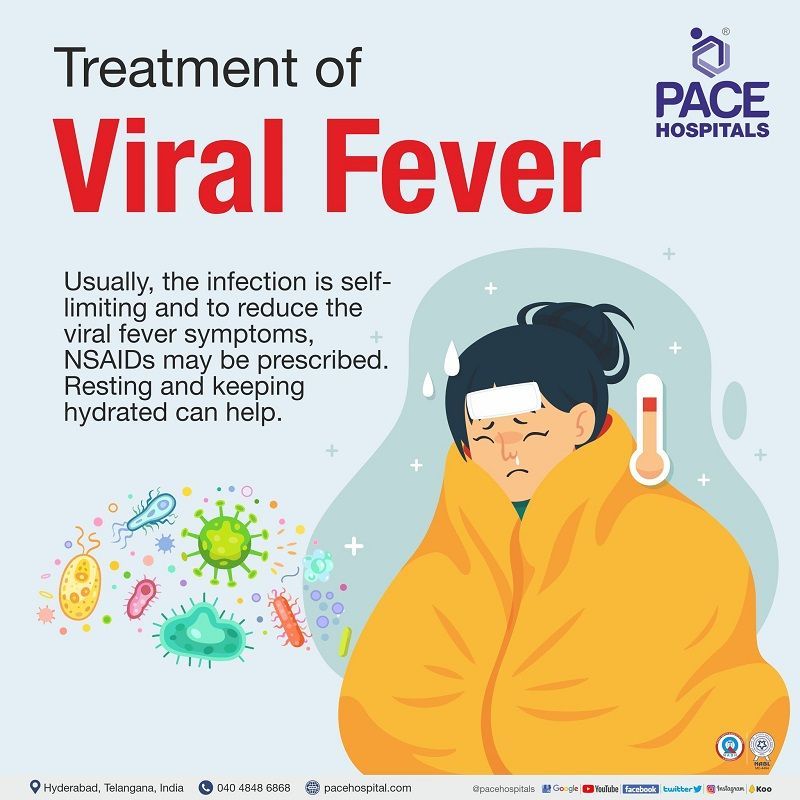
Viral fever prevention
The prevention of viral fever can be done if the spread of viral infection is stopped. Viral fever prevention can be succeeded by the following:
- Frequent handwashing: Rotavirus causes diarrhoea. It can transfer the infections through contaminated human hands and non-porous inanimate surfaces. Therefore, frequent handwashing, especially before food, is necessary.
- Maintaining distance and wearing masks: While there is an accepted notion of spreading respiratory viruses through aerosol transmission, research demonstrated that the spread occurs through contact with contaminated surfaces. Therefore, maintaining distance with infected people and wearing masks are necessary, especially in endemic areas.
- Wiping surfaces with viricidal solutions: Viral contamination was directly implicated or for which viral agents and their spread can be reduced by treating the surfaces with viricidal solutions (such as iodine-based solutions).
- Pasteurization: decreases virus infectivity in milk by several logs. Pasteurization is the act of heating milk to 72 °C for 15 minutes. Similarly, boiling water before drinking ensures a similar effect.
- Prevention of mosquito bites: Mosquitoes can cause the spread of various viruses, especially that causing dengue, chikungunya, etc. Therefore, usage of mosquito nets and repellents could help prevent mosquito bites.
Frequently asked questions, FAQs
-
How many days does viral fever last?
Viral fever duration: Most viral fevers can last 3-4 days, while few of them can last within a day, but the viral fevers, such as dengue fever, can persist for upto 10 days or more.In most circumstances, the viral fevers are self-limiting (healing on their own within some days) with enough rest and being hydrated.
-
Does oxygen level drop in viral fever?
Yes. The levels of oxygen level do drop in the viral fever. This is seen in other non-viral fevers too. In fact, this has been so common that measuring the oxygen saturation (SaO2) by pulse oximetry (SpO2) is one of the routines in hospital settings and has been labelled as the “fifth vital sign" (the other four being an increase in body temperature, pulse rate, breathing rate and capillary refill).
Research tells us that the increase in the temperature of the blood could lead to the decreased affinity of oxygen to haemoglobin, resulting in dipping oxygen levels.
-
Is viral fever contagious?
Yes, the viral fevers are very contagious. Depending upon the time of viral fever in the body, the length of contiguousness varies, such as:
- Bronchitis - It is contagious as long as its symptoms persist.
- Chickenpox - It is contagious for two days, even before its symptoms appear.
- Glandular fever-The fever can be spread seven weeks before the symptoms and until the symptoms are gone.
-
What to eat with viral fever?
Eating nutrient-dense foods is useful during the viral fever. Nutrient-rich foods are beneficial for reducing the viral fever, such as:
- Plenty of non-alcoholic beverages, juices, soups etc., for hydration.
- Milk &milk-based beverages can be taken, but in a few cases, they may induce diarrhoea (loose motion). Avoid if diarrhoea is triggered.
- Low-fibre foods such as refined cereals like suji, dehusked pulses, well-cooked soft vegetables, and fruits.
- Plain gelatin-based desserts, sugar, honey, & jam.
-
Can we take a bath in viral fever?
Yes. Patients with viral fever can take a bath as it can help reduce body temperature. A clean and comfortable body can help in the reduction of body temperature, thus reducing the viral fever. Bathing also relieves bodily aches and pains and dilates peripheral arteries, thereby lowering temperature and preventing convulsions.
-
How do you break a viral fever/viral fever treatment?
Breaking viral fevers can be done by resting enough, being hydrated, using blankets in case of shivering or an ice pack in case of feeling too hot, and using non-steroidal anti-inflammatory drugs (NSAIDs).
Viral fever treatment rarely involves any medicines as it usually goes on its own.
-
Do platelets decrease in viral fever?
Yes. Platelets do get decreased in viral fever. Thrombocytopenia (reduction of blood platelets) could be due to decreased platelet production or increased platelet destruction.
The virus infection induces a decrease in platelet production by infecting the megakaryocytes (cells produced by bone marrow which form platelets later) and increasing the apoptosis (programmed cell death).
As a part of the viral fever treatment, supplements are given to boost the production of platelets.
-
How many platelets drop in viral fever?
A low platelet count (thrombocytopenia) could usually be below 150 × 109/L during many viral infections.
-
How to increase platelet count in viral fever?
A folate-rich diet could be taken to increase the count of platelets in the body due to the viral fevers. Folate is necessary for performing the smooth division of cells in the body and is usually found in cereals, oranges, spinach etc.
-
Can antibiotics cure viral fever?
No. Doctors usually do not prescribe antibiotics for viral fever or viral infections, as antibiotics do not have any effect on viral infections. Doctors only prescribe antibiotics after a thorough diagnosis to treat bacterial infections.
Request an appointment
Fill in the appointment form or call us instantly to book a confirmed appointment with our super specialist at 04048486868
Appointment request - health articles
Thank you for contacting us. We will get back to you as soon as possible. Kindly save these contact details in your contacts to receive calls and messages:-
Appointment Desk: 04048486868
Whatsapp: 8977889778
Regards,
Pace Hospitals
Hitech City and Madinaguda
Hyderabad, Telangana, India.
Oops, there was an error sending your message. Please try again later. We will get back to you as soon as possible. Kindly save these contact details in your contacts to receive calls and messages:-
Appointment Desk: 04048486868
Whatsapp: 8977889778
Regards,
Pace Hospitals
Hitech City and Madinaguda
Hyderabad, Telangana, India.
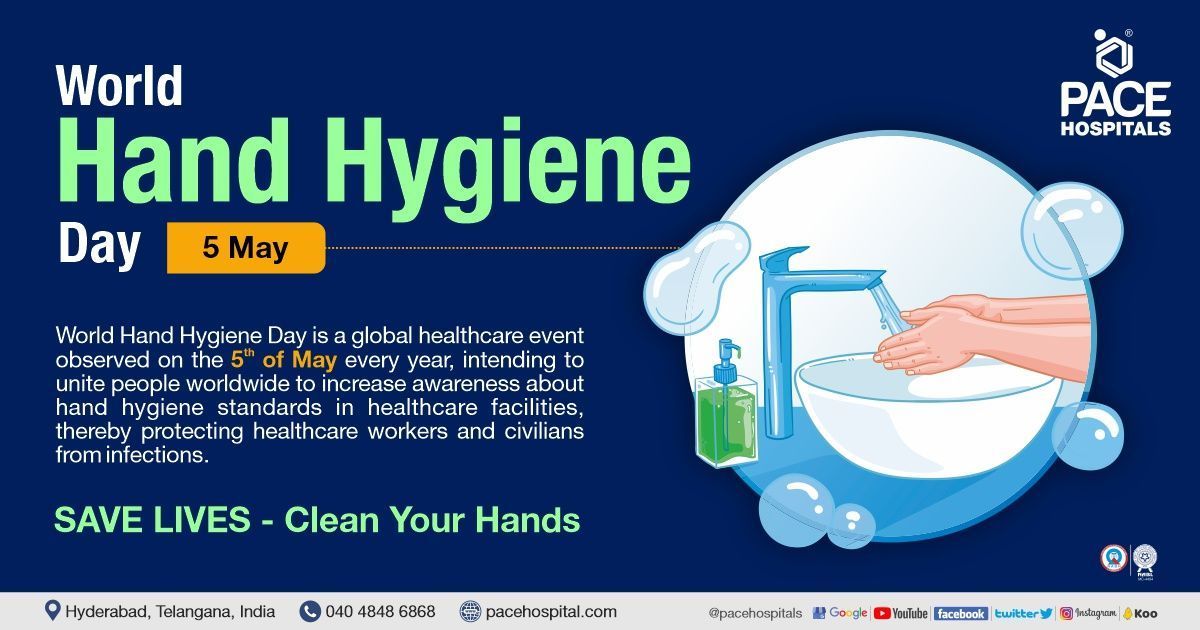
Our Locations
Subscribe to our newsletter and stay updated with the latest health information.
By clicking on subscribe now, you accept to receive communications from PACE Hospitals on email, SMS and Whatsapp.
Subscribe to PACE Hospitals News
Thank you for subscribing. Stay updated with the latest health information.
Oops, there was an error. Please try again submitting your details.
-

Payment in advance for treatment (Pay in Indian Rupees)
For Bank Transfer:-
Bank Name: HDFC
Company Name: Pace Hospitals
A/c No.50200028705218
IFSC Code: HDFC0000545
Bank Name: STATE BANK OF INDIA
Company Name: Pace Hospitals
A/c No.62206858997
IFSC Code: SBIN0020299
Scan QR Code by Any Payment App (GPay, Paytm, Phonepe, BHIM, Bank Apps, Amazon, Airtel, Truecaller, Idea, Whatsapp etc)
Call us at 04048486868
ADDRESS
PACE Hospitals
Hitech City : Beside Avasa Hotel, Pillar No. 18, Hyderabad - 500081
Madinaguda: Mythri Nagar, Beside South India Shopping, Madinaguda, Hyderabad - 500050
QUICK LINKS
Disclaimer
General information on healthcare issues is made available by PACE Hospitals through this website (www.pacehospital.com), as well as its other websites and branded social media pages. The text, videos, illustrations, photographs, quoted information, and other materials found on these websites (here by collectively referred to as "Content") are offered for informational purposes only and is neither exhaustive nor complete. Prior to forming a decision in regard to your health, consult your doctor or any another healthcare professional. PACE Hospitals does not have an obligation to update or modify the "Content" or to explain or resolve any inconsistencies therein.
The "Content" from the website of PACE Hospitals or from its branded social media pages might include any adult explicit "Content" which is deemed exclusively medical or health-related and not otherwise. Publishing material or making references to specific sources, such as to any particular therapies, goods, drugs, practises, doctors, nurses, other healthcare professionals, diagnoses or procedures is done purely for informational purposes and does not reflect any endorsement by PACE Hospitals as such.

